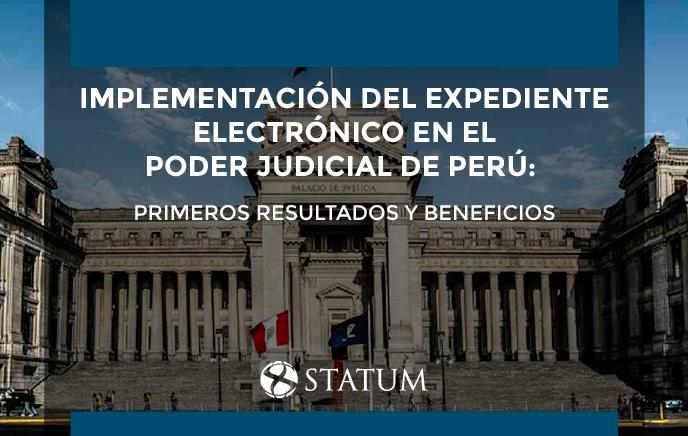Implementación del Expediente electrónico en el Poder Judicial de Perú: primeros resultados y beneficios
Resumen:
En febrero de 2014, se realizó una reunión de trabajo en la Sala de Audiencias N° 3 con el objetivo de dar a conocer el alcance de la implementación del Expediente Judicial Digital aplicado en la Corte Superior de Justicia (CSJ) de Lima Norte.
Información:
En el sistema judicial peruano, y en la región en general, la ciudadanía cuestionaba básicamente dos asuntos: la lentitud de los procesos judiciales y, por otro lado, algunos márgenes sustantivos de corrupción.
Para aliviar tales cuestiones, desde aquella fecha se persiguió el objetivo de transformar la concepción dominante del uso tecnológico (luchando contra ciertas resistencias) para abordar el cumplimiento de procesos digitales más complejos. Esta necesidad logró materializarse en el mes de noviembre de 2014, cuando Perú oficializó su ingreso en la era de la informatización gracias a la plataforma ApiaDocumentum de STATUM.
La inauguración fue calificada como un "hecho histórico" por el presidente del Poder Judicial, Enrique Mendoza, con un alcance que abarcó a la propia Corte Suprema peruana, y se extendió también a las salas con especialización en el área comercial, familiar, remates electrónicos y resoluciones entre litigantes.
El sistema transaccional con el que los operadores están trabajando a partir del expediente electrónico generó consecuentemente la ventaja de transparencia. Esta es una característica que el formato papel no permitía y que ahora se podrá apreciar especialmente en el área de despacho gracias a la celeridad e inalterabilidad de la carga procesal.
La tecnología también permitió otras características fundamentales como la inmediación y la oralidad, sobre todo en el área laboral.
Se proyecta que, en 2919, todo el Poder Judicial de Perú podrá hacer uso del expediente electrónico, gracias al cual el Estado ahorrará unos 11 millones de soles anuales solamente en la compra de papel. Esta es una mejora de vital importancia en un país cuya producción jurisdiccional asciende a más de 2 millones de causas, emitiéndose aproximadamente 5.000 resoluciones diarias.
Si desea más información, puede ver los videos sobre el Expediente Digital Judicial producidos por el Poder Judicial de Perú:
https://www.youtube.com/watch?v=AV0WxesMGNA
https://www.youtube.com/watch?v=QbaZxT4rz7Y
https://www.youtube.com/watch?v=CbLM0p4Yi-o
https://www.youtube.com/watch?v=_HtoHatPdWE
https://www.youtube.com/watch?v=Vi7qezR1N1U
https://www.youtube.com/watch?v=6m3SVExvzQs
En febrero de 2014, se realizó una reunión de trabajo en la Sala de Audiencias N° 3 con el objetivo de dar a conocer el alcance de la implementación del Expediente Judicial Digital aplicado en la Corte Superior de Justicia (CSJ) de Lima Norte.
Información:
En el sistema judicial peruano, y en la región en general, la ciudadanía cuestionaba básicamente dos asuntos: la lentitud de los procesos judiciales y, por otro lado, algunos márgenes sustantivos de corrupción.
Para aliviar tales cuestiones, desde aquella fecha se persiguió el objetivo de transformar la concepción dominante del uso tecnológico (luchando contra ciertas resistencias) para abordar el cumplimiento de procesos digitales más complejos. Esta necesidad logró materializarse en el mes de noviembre de 2014, cuando Perú oficializó su ingreso en la era de la informatización gracias a la plataforma ApiaDocumentum de STATUM.
La inauguración fue calificada como un "hecho histórico" por el presidente del Poder Judicial, Enrique Mendoza, con un alcance que abarcó a la propia Corte Suprema peruana, y se extendió también a las salas con especialización en el área comercial, familiar, remates electrónicos y resoluciones entre litigantes.
El sistema transaccional con el que los operadores están trabajando a partir del expediente electrónico generó consecuentemente la ventaja de transparencia. Esta es una característica que el formato papel no permitía y que ahora se podrá apreciar especialmente en el área de despacho gracias a la celeridad e inalterabilidad de la carga procesal.
La tecnología también permitió otras características fundamentales como la inmediación y la oralidad, sobre todo en el área laboral.
Se proyecta que, en 2919, todo el Poder Judicial de Perú podrá hacer uso del expediente electrónico, gracias al cual el Estado ahorrará unos 11 millones de soles anuales solamente en la compra de papel. Esta es una mejora de vital importancia en un país cuya producción jurisdiccional asciende a más de 2 millones de causas, emitiéndose aproximadamente 5.000 resoluciones diarias.
Si desea más información, puede ver los videos sobre el Expediente Digital Judicial producidos por el Poder Judicial de Perú:
https://www.youtube.com/watch?v=AV0WxesMGNA
https://www.youtube.com/watch?v=QbaZxT4rz7Y
https://www.youtube.com/watch?v=CbLM0p4Yi-o
https://www.youtube.com/watch?v=_HtoHatPdWE
https://www.youtube.com/watch?v=Vi7qezR1N1U
https://www.youtube.com/watch?v=6m3SVExvzQs





Comentarios (0)
Deja un comentario